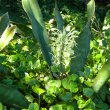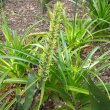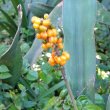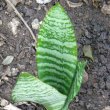| Botanical Name |
Sansevieria hyacinthoides |
| Family |
Asparagaceae - The asparagus family. |
| Pronunciation |
san-se-VEER-ee-uh hy-uh-sin-THOY-deez |
| Common Name(s) |
English: Mother-in-law's tongue; Piles root
Afrikaans: Skoonma -se-tong; aambeiwortel
IsiZulu: Isikholokotho; Isikhwendle
|
| Plant Group |
- Succulent A plant having fleshy stems or leaves often adapted to dry conditions.
|
| Plant Size |
- Medium
| Tree | 10m to 16m |
| Shrub | 1m to 2m |
| Perennial/ground cover | 40cm to 60cm |
| Bulb | 40cm to 60cm |
| Succulent | 40cm to 60cm |
|
| Position |
- Canopy Shade Canopy shade is found below closely grown trees where some light filters through. Ideal for the protection of herbaceous plants.
- Deep / Full Shade Shade below spreading evergreen trees where sun's rays are unable to penetrate the canopy at any time. For light sensitive plants
- Dry Shade Shady areas where soil has poor water retention or are dependent on rain for their moisture needs.
- Light or Dappled Shade Found below trees with sparse, open foliage. Ideal for the protection of herbaceous plants.
- Partial Shade The area is in shade for part of the day and in full sun for part of the day.
- Sun The area is in full sun for all or most of the day, all year round.
|
| General Information |
- Attractive fruits, berries or seeds Brightly coloured fruits or berries increase and extend the visual impact of the plant and are especially attractive to birds and other small wildlife.
- Drought Tolerance: High The plant is well adapted to arid conditions; it can survive long periods of drought and high temperatures without extra water.
- Evergreen Plants that have leaves all year round.
- Frost: Half-hardy The plant is able to survive low temperatures and some frost but requires protection against severe frost.
- Sand tolerant Plants adapted to survive in nutrient poor, very sandy soils.
- Water Wise Plant species originating from low rainfall regions that require less water to survive and thrive than other plant species.
|
| Specific Information |
Sansevieria hyancinthanoides is an extremely durable and tough plant with long, linear leaves, often with light green contrasting horizontal markings. It will grow in full sun but is far more vigourous and attractive grown in shade.
|
| Ad Break |
|
| Flowers |
| Description |
large stem of long, narrow blooms, followed by orange fruit
|
| Season |
- Summer Plants will seldom bloom for the entire season as given in the list, but should flower during a period within these parameters.
|
| Colour |
|
| Growth Rate |
- Moderate Specifying growth rate can be very misleading as there is considerable variation of growth rate depending on type and species of plant, available water, supplementary feeding, mulching and general care, as well as the plants suitability and adaptability to the garden environment.
|
| Plant Uses |
- Accent or Focal Point A plant used to attract the attention because of its colour or form.
- Attracts bees, butterflies or other insects This plant attracts insects which can be food for birds or other creatures in your garden.
- Attracts Birds This plant will attract birds.
- Border A strip of ground, at the edge of a driveway or path in which ornamental plants or shrubs are planted.
- Boundary A plant useful for planting around the edges of the property to form a green or colourful backdrop, an impenetrable hedge, to hide walls or create privacy.
- Container Trees, shrubs and ornamental species that can adapt to growing in a restricted environment.
- Filler Either a fast growing tree or shrub used temporarily to fill in an area while the permanent plants grow to a desired size, or a plant used to fill gaps in borders or beds.
- Foliage Plant Plants grown because their foliage is colorful or unique. Many of these plants have insignificant flowers.
- Interplanting Arranging and planting plants in the garden that have different blooming times and habits of growth, extending the amount of time in which the area is in flower.
- Pot Plant A plant that needs a protected environment on a patio or indoors.
- Rock Garden An area constructed of larger rocks, arranged naturally, to emphasise the use of stones as a main element. Generally plants used do not need a lot of care.
- Suitable for coastal gardens Plants adapted to dry, sandy soil, forceful wind, limited rainfall and intense sunlight.
- Suitable for seaside gardens Plants that will survive the hostile environment of harsh salty winds, dry sandy soil, irregular rainfall and heat found in seaside gardens.
- Water Features These plants may have dramatic, lush foliage or graceful form. They do not shed excessive leaves and do not have invasive root systems.
- Wild Garden An indigenous garden planted for the benefit of wildlife and birds. Provides food, water, a variety of mini-biomes and no poisonous chemicals are used.
|
| Distribution and Habitat |
Eastern Cape, KwaZulu-Natal and Mpumalanga, Gauteng and Limpopo, as well as Mozambique Zimbabwe and Namibia, on rocky outcrops and in woodlands
|
| Planting Suggestions |
Plant in well drained garden soil mixed with plenty of compost and mulch. Water regularly until established, after which water need only be supplemented during particularly dry spells.
|
| Medicinal Uses |
The rhizomes and leaves of Sanseveria are used for earache, stomach ache, toothache, ulcers, haemorrhoids, diarrhoea and internal parasites. A strong rope is made from the fibres in the leaves.
|
| Ad Break |
|










Comments
Mother-in-law's tongue
Thanks for an informative website. May I find out if there is a special way to prepare the motherinlaw tongue leaf if you want to use for earache?
Sansevieria for earache
According to Margaret Roberts in her book Indigenous Healing Plants, a leaf is cut from the plant and heated. The warm (not hot!) juice is gathered in a teaspoon and poured into the ear. A warmed piece of leaf is simultaneously held behind the ear until the pain recedes.
mother-in-law's tongue
Sadly I have learnt that these usually very hardy plants do NOT like too much water. Once a month is enough. Years ago I had them happily growing indoors and watered them sometimes once in 6 months, and they thrived . However because I now live in the Little Karoo, and they were in pots outdoors, I watered them frequently and made them very sad!!
One easily forgets that they
One easily forgets that they are succulents and need little water to survive. I checked the distribution map and it shows all of the Little Karoo as part of this Sansevieria's natural habitat. Your plants have come home!
Skoonma se Tong
I have been given he advise to drink the extract from the roots of this plant, crushed and soaked in water in order to enhance blood circulation to my feet.
Any suggestions where I can find some of these roots?
Will the roots have to be fresh or can they be dry when withdrawing this extract?
where can I find seeds of a variety which grows locally?
I line in Polokwane (Pietersburg) Limpopo
Tel no 082 785 1142
Medical use
Hi Hennie
I am unable to supply you with much information as I am not a trained, registered Sangoma or Healer. For this it is best to visit a muthi shop in your area where you can be informed of dosage, method of preparation and so on. I have found most these establishments to be very helpful and obliging.
Sansevieria hyancinthoides does grow in Limpopo. I do not know if other varieties of Sanseviera have the same uses as S. hyancinthoides. Go to: http://redlist.sanbi.org/genus.php?genus=1787 for a list of other species of this plant.
You can try Silverhill Seeds (silverhillseeds.co.za) or Bid or buy to search for seeds.
Kind regards
Lorraine
Discuss this plant
Share knowledge, ask a question or give an experience.